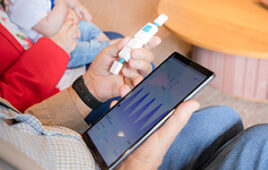
This fully automated device includes an image-guided robot for drawing blood from veins, a sample-handling module and a centrifuge-based blood analyzer.
A new fully automated medical device could enable end-to-end blood testing at the point of care with quick results.
Scientists from Rutgers University have developed a device for automated blood drawing and testing that could provide rapid test results at bedsides or in ambulances, emergency rooms, clinics or doctors’ offices, foregoing the need to have clinicians examine the blood tests at centralized labs.
“This device represents the holy grail in blood testing technology,” Martin Yarmush, senior author of the study and Paul & Mary Monroe Endowed Chair & Distinguished Professor in the Department of Biomedical Engineering at Rutgers University-New Brunswick, said in a statement. “Integrating miniaturized robotic and microfluidic [lab-on-a-chip] systems, this technology combines the breadth and accuracy of traditional blood drawing and laboratory testing with the speed and convenience of point-of-care testing.”
The new systems couples an image-guided venipuncture robot that addresses the challenges of routine venous access, with a centrifuge-based blood analyzer to obtain quantitative measurements of hematology.
The researchers first demonstrated a white blood cell assay on the analyzer by using a blood mimicking fluid spiked with fluorescent microbeads. The area of the packed bead layer is correlated with the bead concentration.
The team then performed experiments to evaluate the pumping efficiency of the sample handling module, followed by studies on the integrated device—from blood draw to analysis—using blood vessel phantoms to assess the accuracy and repeatability of the resulting white blood cell assay.
“When designing the system, our focus was on creating a modular and expandable device,” Max Balter, PhD, who led the study, said in a statement. “With our relatively simple chip design and analysis techniques, the device can be extended to incorporate a broader panel of tests in the future.”
Diagnostic blood testing is the most commonly performed clinical procedure in the world. However, the tests success rate is dependent on the clinicians’ skill and the patient’s physiology. In addition, almost all of the test results are produced by centralized labs that handle a substantial amount of samples and use labor-intensive analytical techniques.
The study was published in TECHNOLOGY.




